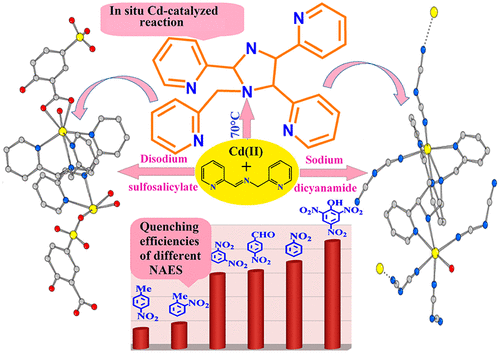当前位置:
X-MOL 学术
›
Cryst. Growth Des.
›
论文详情
Our official English website, www.x-mol.net, welcomes your feedback! (Note: you will need to create a separate account there.)
Tetranuclear and 1D Polymeric Cd(II) Complexes with a Tetrapyridyl Imidazolidine Ligand: Synthesis, Structure, and Fluorescence Sensing Activity
Crystal Growth & Design ( IF 3.8 ) Pub Date : 2020-03-24 , DOI: 10.1021/acs.cgd.9b01192 Aparup Paul 1 , Ennio Zangrando 2 , Apu Patra 1 , Manas Kumar Mahish 1 , Dama Saren 1 , Hyuma Masu 3 , Subal Chandra Manna 1
Crystal Growth & Design ( IF 3.8 ) Pub Date : 2020-03-24 , DOI: 10.1021/acs.cgd.9b01192 Aparup Paul 1 , Ennio Zangrando 2 , Apu Patra 1 , Manas Kumar Mahish 1 , Dama Saren 1 , Hyuma Masu 3 , Subal Chandra Manna 1
Affiliation

|
Two novel coordination compounds of cadmium, [Cd2L1(ssal)2(H2O)3]2·10H2O (1) and {[Cd2L1(dca)4(H2O)]·H2O}n (2) (where L1 = 2,2′,2″-(1-(pyridin-2-ylmethyl)imidazolidine-2,4,5-triyltripyridine), ssal = sulfosalicylate, and dca = dicyanamide), have been synthesized under reflux conditions. The nitrogen-rich ligand L1 was formed in situ by Cd(II)-mediated coupling cycloaddition of the Schiff base N-(2-pyridylmethyl)pyridine-2-carbaldimine: thus, through a Cd(II)-catalyzed reaction. In the two species sulfosalicylate or dicyanamide anions act as a coligand. The single-crystal X-ray structural analyses revealed that 1 is a discrete centrosymmetric tetranuclear complex crystallizing with 10 lattice water molecules that favor the formation of a 3D supramolecular structure through H bonds. On the other hand complex 2 is a coordination polymer built by bridging dca anions connecting −[Cd1(L1)Cd2]– building blocks. The polymers are further connected by H bonds involving the coordinated and lattice water molecules with terminal dca N atoms of symmetry-related chains. The luminescent properties of complexes 1 and 2 were investigated in various organic solvents, and both complexes show a highly selective sensitive response toward nitroaromatic compounds, especially toward picric acid (PA). The possible quenching mechanism of the process has been validated by the combined effect of energy and electron transfer mechanisms as well as electrostatic interactions.
中文翻译:

四核和一维聚合Cd(II)配合物与四吡啶基咪唑烷配体:合成,结构和荧光传感活性。
镉的两种新型配位化合物[Cd 2 L 1(ssal)2(H 2 O)3 ] 2 ·10H 2 O(1)和{[Cd 2 L 1(dca)4(H 2 O)]·H 2 O} n(2)(其中L 1 = 2,2',2″-(1-(吡啶-2-基甲基)亚咪唑烷-2,4,5-三基三吡啶),ssal =磺基水杨酸酯,dca =二氰胺) ,已在回流条件下合成。富氮配体L 1通过席夫碱的Cd(II)介导的偶联环加成反应原位形成N-(2-吡啶基甲基)吡啶-2-甲二胺:因此,通过Cd(II)催化的反应。在这两种物质中,磺基水杨酸根或双氰胺阴离子充当大肠菌。单晶X射线结构分析表明,1是离散的中心对称四核络合物,具有10个晶格水分子结晶,有利于通过H键形成3D超分子结构。另一方面,络合物2是通过桥联连接-[Cd1(L 1)Cd2]-结构单元的dca阴离子而构建的配位聚合物。聚合物进一步通过涉及配位和晶格水分子的H键与对称相关链的末端dca N原子连接。配合物1和1的发光特性在各种有机溶剂中对2进行了研究,两种配合物均显示出对硝基芳族化合物(特别是对苦味酸(PA))的高度选择性敏感反应。该方法可能的淬灭机理已通过能量和电子转移机理以及静电相互作用的综合作用得到了验证。
更新日期:2020-03-24
中文翻译:

四核和一维聚合Cd(II)配合物与四吡啶基咪唑烷配体:合成,结构和荧光传感活性。
镉的两种新型配位化合物[Cd 2 L 1(ssal)2(H 2 O)3 ] 2 ·10H 2 O(1)和{[Cd 2 L 1(dca)4(H 2 O)]·H 2 O} n(2)(其中L 1 = 2,2',2″-(1-(吡啶-2-基甲基)亚咪唑烷-2,4,5-三基三吡啶),ssal =磺基水杨酸酯,dca =二氰胺) ,已在回流条件下合成。富氮配体L 1通过席夫碱的Cd(II)介导的偶联环加成反应原位形成N-(2-吡啶基甲基)吡啶-2-甲二胺:因此,通过Cd(II)催化的反应。在这两种物质中,磺基水杨酸根或双氰胺阴离子充当大肠菌。单晶X射线结构分析表明,1是离散的中心对称四核络合物,具有10个晶格水分子结晶,有利于通过H键形成3D超分子结构。另一方面,络合物2是通过桥联连接-[Cd1(L 1)Cd2]-结构单元的dca阴离子而构建的配位聚合物。聚合物进一步通过涉及配位和晶格水分子的H键与对称相关链的末端dca N原子连接。配合物1和1的发光特性在各种有机溶剂中对2进行了研究,两种配合物均显示出对硝基芳族化合物(特别是对苦味酸(PA))的高度选择性敏感反应。该方法可能的淬灭机理已通过能量和电子转移机理以及静电相互作用的综合作用得到了验证。


























 京公网安备 11010802027423号
京公网安备 11010802027423号